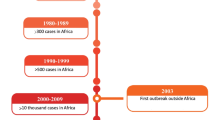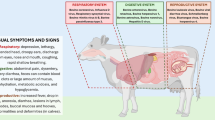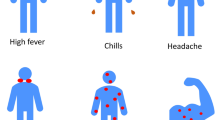Abstract
In this paper, we report the resurgence of lumpy skin disease (LSD) in Kurgan Oblast, Russia, in 2018. The majority of the outbreaks were silent with no mortality and congregated within an area with a radius of about 30 km located 1–50 km away from the national border with Kazakhstan. Following primary molecular diagnosis, LSD virus (LSDV) isolates were analyzed using a panel of PCR assays targeting different genetic loci, namely, LSD008 (vaccine), LSDV126 (field), and GPCR (vaccine and field), for differentiation and genotype assignment. All isolates were positive for the vaccine genotype of GPCR and negative for the other field targets tested. A PCR assay with melt curve analysis utilizing LSD008, developed in this work, indicated that the strains melted with a profile similar to those of field strains. Surprisingly, sequence analysis of the RPO30 and GPCR genes aligned the Kurgan/2018 isolate with KSGP O-240 at the GPCR locus, but with Saratov/2017 at the RPO30 locus. The latter cluster forms an association with a sub-cluster of the field strains comprising the South African KSGP O-240 strain and NI-2490 strain. Due to these incongruent phylogenetic patterns, the sequences of three additional loci ORF19 (Kelch-like protein), ORF52 (putative transcriptional elongation factor), and ORF87 (mutT motif protein) were investigated. Phylogenetic analysis of these additional loci placed the strain Kurgan/2018 in either vaccine or field groups, strongly suggesting a novel recombinant profile. This is another piece of evidence exposing the potential for recombination in capripoxviruses and the ignored danger of using live homologous vaccines against LSD. The necessity to revise the PCR-based strategy differentiating infected from vaccinated animals is discussed. The potential scenarios of incursion and the contribution of the KSGP/NI-2490-like strain to the emergence of the recently identified vaccine-like recombinant are discussed.













Similar content being viewed by others
References
Sprygin A, Artyuchova E, Babin Yu, Prutnikov P, Kostrova E, Byadovskaya O, Kononov A (2018) Epidemiological characterization of lumpy skin disease outbreaks in Russia in 2016. Transbound Emerg Dis 65(6):1514–1521
Mercier A, Arsevska E, Bournez L, Bronner A, Calavas D, Cauchard J, Falala S, Caufour P, Tisseuil C, Lefrançois T, Lancelot R (2018) Spread rate of lumpy skin disease in the Balkans, 2015–2016. Transbound Emerg Dis 65(1):240–243
Coetzer JA (2004) Lumpy skin disease. In: Coetzer JAW, Tustin RC (eds) Infectious diseases of livestock. University Press Southern Africa, Oxford, pp 1268–1276
Babiuk S, Bowden TR, Parkyn G, Dalman B, Manning L, Neufeld J, Embury-Hyatt C, Copps J, Boyle DB (2008) Quantification of lumpy skin disease virus following experimental infection in cattle. Transbound Emerg Dis 55:299–307
Irons PC, Tuppurainen ESM, Venter EH (2005) Excretion of lumpy skin disease virus in bull semen. Theriogenology 63:1290–1297
Annandale CH, Holm DE, Ebersohn K, Venter EH (2013) Seminal transmission of lumpy skin disease virus in heifers. Transbound Emerg Dis 61:443–448
Annandale CH, Irons PC, Bagla VP, Osuagwuh UI, Venter EH (2010) Sites of persistence of lumpy skin disease virus in the genital tract of experimentally infected bulls. Reprod Domest Anim 45:250–255
Molla W, de Jong M, Gari G, Frankena K (2017) Economic impact of lumpy skin disease and cost effectiveness of vaccination for the control of outbreaks in Ethiopia. Prev Vet Med 147:100–107
Chihota CM, Rennie LF, Kitching RP, Mellor PS (2003) Attempted mechanical transmission of lumpy skin disease virus by biting insects. Med Vet Entomol 17:294–300
Sprygin A, Pestova Y, Wallace DB, Tuppurainen E, Kononov A (2019) Transmission of lumpy skin disease: a short review. Virus Res 269:197637
Kahana-Sutin E, Klement E, Lensky I, Gottlieb Y (2017) High relative abundance of the stable fly Stomoxys calcitrans is associated with lumpy skin disease outbreaks in Israeli dairy farms. Med Vet Entomol 31:150–160
Chihota CM, Rennie LF, Kitching RP, Mellor PS (2001) Mechanical transmission of lumpy skin disease virus by Aedes aegypti (Diptera: Culicidae). Epidemiol Infect 126:317–321. https://doi.org/10.1017/S0950268801005179
Tuppurainen ES, Lubinga JC, Stoltsz WH, Troskie M, Carpenter ST, Coetzer JA, Venter EH, Oura CA (2013) Mechanical transmission of lumpy skin disease virus by Rhipicephalus appendiculatus male ticks. Epidemiol Infect 141(2):425–430
Weiss KE (1968) Lumpy skin disease virus. Virol Monogr 3:111–131
Kononov A, Byadovskaya O, Kononova S, Yashin R, Zinyakov N, Mischenko V, Perevozchikova N, Sprygin A (2019) Detection of vaccine-like strains in the 2017 outbreaks of lumpy skin disease virus in Russia. Arch Virol 164(6):1575–1585
Sprygin A, Babin Y, Pestova Y, Kononova S, Wallace DB, Van Schalkwyk A, Byadovskaya O, Diev V, Lozovoy D, Kononov A (2018) Analysis and insights into recombination signals in lumpy skin disease virus recovered in the field. PLoS One 13(12):e0207480. https://doi.org/10.1371/journal.pone.0207480(eCollection 2018)
Sprygin A, Pestova Y, Kostrova E, Kononova S, Byadovskaya O, Zhbanova T, Kononov A (2019) One-run real time PCR assays for the detection of capripoxviruses, field isolates and vaccine strains of lumpy skin disease virus. Sel’skokhozyaistvennaya Biologiya 54(2):347–358
Sprygin A, Pestova Ya, Prutnikov P, Kononov A (2018) Detection of vaccine lumpy skin disease virus in cattle and Musca domestica L. flies in an outbreak of lumpy skin disease in Russia in 2017. Transbound Emerg Dis 65(5):1137–1144
Agianniotaki EI, Chaintoutis SC, Haegeman A, Tasioudi KE, De Leeuw I, Katsoulos PD, Sachpatzidis A, De Clercq K, Alexandropoulos T, Polizopoulou ZS, Chondrokouki ED, Dovas CI (2017) Development and validation of a TaqMan probe-based real-time PCR method for the differentiation of wild type lumpy skin disease virus from vaccine virus strains. J Virol Methods 249:48–57
Lamien CE, Le Goff C, Silber R et al (2011) Use of the Capripoxvirus homologue of Vaccinia virus 30 kDa RNA polymerase subunit (RPO30) gene as a novel diagnostic and genotyping target: development of a classical PCR method to differentiate goat poxvirus from sheep poxvirus. Vet Microbiol 149:30–39
Le Goff C, Lamien CE, Fakhfakh E, Chadeyras A, Aba-Adulugba E, Libeau G, Tuppurainen E, Wallace DB, Adam T, Silber R, Gulyaz V, Madani H, Caufour P, Hammami S, Diallo A, Albina E (2009) Capripoxvirus G-protein-coupled chemokine receptor: a host-range gene suitable for virus animal origin discrimination. J Gen Virol 90(Pt 8):1967–1977
Sprygin A, Babin Yu, Pestova A, Kononova S, Byadovskaya A, Kononov A (2019) Complete genome sequence of the lumpy skin disease virus recovered from the first outbreak in the Northern Caucasus of Russia in 2015. Genome Announc 8:e01733-18
Osuagwuh UI, Bagla V, Venter EH, Annandale CH, Irons PC (2007) Absence of lumpy skin disease virus in semen of vaccinated bulls following vaccination and subsequent experimental infection. Vaccine 25:2238–2243
Kononov A, Prutnikov P, Shumilova I, Kononova S, Nesterov A, Byadovskaya O, Pestova Ya, Diev V, Sprygin A (2019) Determination of lumpy skin disease virus in bovine meat and offal products following experimental infection. Transbound Emerg Dis 66(3):1332–1340
Menasherow S, Erster O, Rubinstein-Giuni M, Kovtunenko A, Eyngor E, Gelman B, Khinich E, Stram Y (2016) A high-resolution melting (HRM) assay for the differentiation between Israeli field and Neethling vaccine lumpy skin disease viruses. J Virol Methods 232:12–15
Adedeji AJ, Möller J, Meseko CA, Adole JA, Tekki IS, Shamaki D, Hoffmann B (2019) Molecular characterization of Capripox viruses obtained from field outbreaks in Nigeria between 2000 and 2016. Transbound Emerg Dis 66(4):1631–1641
Biswas S, Noyce R, Babiuk L, Lung O, Bulach D, Bowden T, Boyle D, Babiuk S, Evans D (2019) Extended sequencing of vaccine and wild-type capripoxvirus isolates provides insights into genes modulating virulence and host range. Transbound Emerg Dis. https://doi.org/10.1111/tbed.13322
Tuppurainen ES, Pearson CR, Bachanek-Bankowska K, Knowles NJ, Amareen S, Frost L, Henstock MR, Lamien CE, Diallo A, Mertens PP (2014) Characterization of sheep pox virus vaccine for cattle against lumpy skin disease virus. Antiviral Res 109:1–6
Bedeković T, Šimić I, Krešić N, Lojkić I (2018) Detection of lumpy skin disease virus in skin lesions, blood, nasal swabs and milk following preventive vaccination. Transbound Emerg Dis 65(2):491–496
VIRUS, OIE—Terrestrial Animal Health Code—28/06/2019 CHAPTER 11.9. INFECTION WITH LUMPY SKIN DISEASE. s.l.: Article 11.9.1
Acknowledgements
The authors acknowledge Antoinette Van Schalkwyk (ARC-Onderstepoort Veterinary Research institute, South Africa) for providing the primer sequences and valuable comments on the manuscript.
Author information
Authors and Affiliations
Corresponding author
Ethics declarations
Conflict of interest
The authors declare no conflict of interest.
Ethical approval
This study does not include any experiments with human subjects or animals performed by the authors.
Additional information
Handling Editor: William G Dundon.
Publisher's Note
Springer Nature remains neutral with regard to jurisdictional claims in published maps and institutional affiliations.
Rights and permissions
About this article
Cite this article
Aleksandr, K., Pavel, P., Olga, B. et al. Emergence of a new lumpy skin disease virus variant in Kurgan Oblast, Russia, in 2018. Arch Virol 165, 1343–1356 (2020). https://doi.org/10.1007/s00705-020-04607-5
Received:
Accepted:
Published:
Issue Date:
DOI: https://doi.org/10.1007/s00705-020-04607-5




